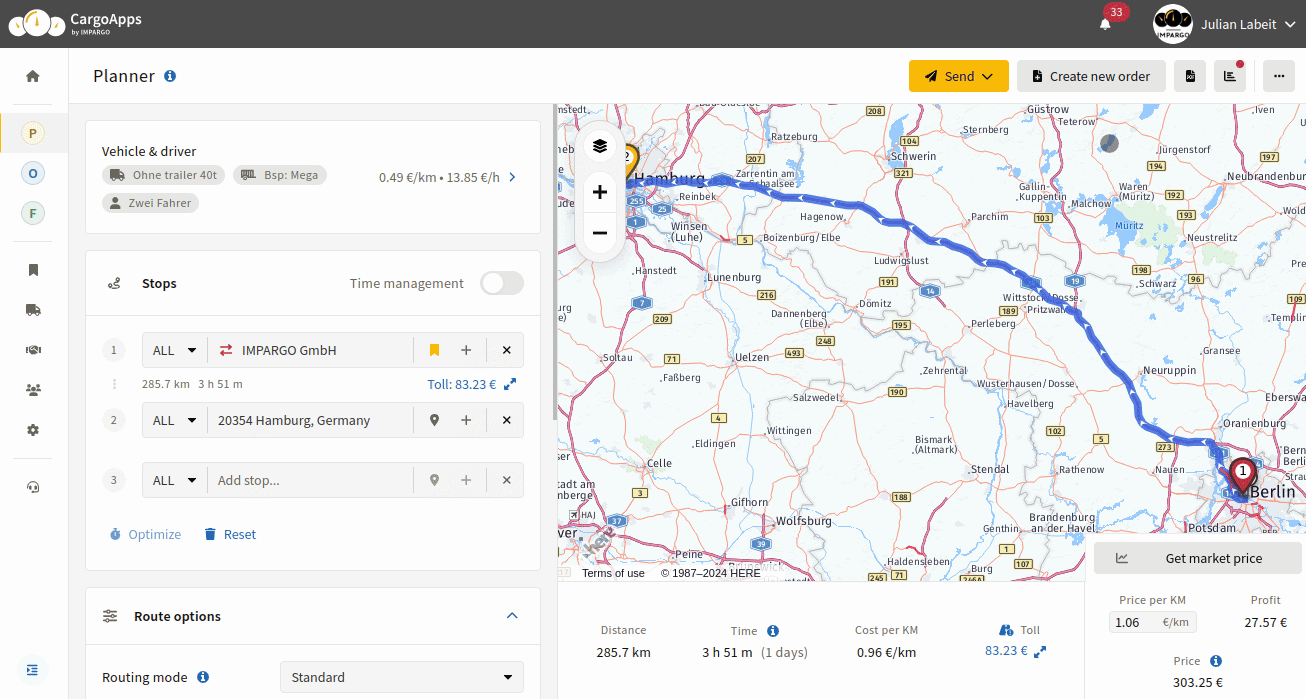IMPARGO Knowledge Center
Unleash the full potential of our software with our comprehensive Knowledge Center, offering detailed information on its functionality and features.
Calculate Truck CO2 Emissions
1. Calculate CO₂ Emissions (General Steps)
Step 1: Measure fuel consumption.
Measure how much fuel the truck uses when it travels a certain distance. For trucks, this is usually measured in how many litres of fuel are used every 100 kilometres travelled.
Step 2: Identify type of fuel used.
Different types of fuel, like diesel or gasoline, release different amounts of CO₂ when burned. Each type of fuel has a CO₂ emission factor, which is a number telling you how much CO₂ is released per litre of that fuel when it's burned.
Step 3: Calculate total emissions.
Multiply the distance the truck travelled by the fuel consumption. This tells you how much fuel was used in total. Then, multiply the total fuel used by the CO₂ emission factor for the type of fuel the truck uses. This gives you the total CO₂ emissions.
With the IMPARGO truck route planner, all these steps are automated, allowing you to automatically calculate and track emissions quickly and effortlessly.
2. Importance of CO₂ Emissions Calculation
Calculating CO₂ emissions is crucial for businesses aiming to reduce their environmental footprint and enhance sustainability. Accurate CO₂ calculations are particularly critical in the logistics and transportation sectors, where they help compare truck efficiencies, meet customer reporting demands, and achieve internal sustainability objectives. This process not only boosts operational efficiency but also ensures compliance with environmental regulations and increases transparency for stakeholders. Understanding and managing CO₂ emissions is essential for any business committed to responsible environmental practices and effective resource management.
3. Calculate Truck Route CO₂ emissions
Step 1: Calculate the route.
Input start and end locations in the "Stops" section (→ Planner Module).
Step 2: Open analysis modal.
Open the analysis modal by clicking on the “Analysis” button at the top right corner of the planner module.
Step 3: Switch to “CO₂ Emissions” tab.
The analysis modal shows details of the tours like a cost breakdown and CO₂ emissions. Switch to the CO₂ emissions tab.
Step 4: Check vehicle parameters and emissions results.
- On the left side of the CO₂ emissions tab, review the vehicle details such as fuel consumption and fuel type, taken from the vehicle profile. If calculating routes for a partner, specify these parameters now.
- On the right side, the modal displays the CO₂ emissions for the route in kilograms of CO₂ equivalent emissions (kg CO₂e), calculated according to ISO 14083:2023 Standard, segmented into Well-to-Tank, Tank-to-Wheel, and Total Emissions.

4. IMPARGO CO₂ Calculation Standard
There are many different ways CO₂ emissions can be calculated and reported. For example, you can choose to include or exclude the emissions that occur when producing the fuel. You can also include or exclude other greenhouse gas emissions apart from CO₂, like methane (CH4) and nitrous oxide (N2O). To understand the details of what the shown emissions include and do not include, we need to delve into how the values are calculated. Understanding the methodology and standards behind CO₂ emissions calculations is key to ensuring accuracy and compliance.
ISO 14083:2023 Standard
As a reference for the CO₂ calculation, the ISO 14083:2023 Standard is used. This international standard provides guidelines for quantifying and reporting greenhouse gas emissions, ensuring consistency and reliability across different calculations.
CO₂ and CO₂e
CO₂ refers to carbon dioxide emissions resulting directly from fossil fuel combustion.
CO₂e (carbon dioxide equivalent) includes CO₂ and other greenhouse gases like methane and nitrous oxide, adjusted to their impact relative to CO₂. According to the used standard, we report CO₂e emissions.
Well-to-Tank (WTT) vs. Tank-to-Wheel (TTW)
WTT (Well to Tank) accounts for the emissions involved in extracting, producing, and transporting the fuel to the vehicle. TTW (Tank to Wheel) measures the emissions produced from the vehicle’s fuel consumption during operation. Typically, people only consider Tank-to-Wheel emissions as these are the emissions that occur when burning the fuel but forget about the emissions needed to produce the fuel. However, to get an accurate calculation of the total emissions needed for a transport, both TTW and WTT need to be considered.
5. Example CO₂ Calculation for a Truck
Imagine a diesel truck travels 100 kilometres using 30 litres of diesel. According to the used standard, diesel available in Europe has the following CO₂ equivalent (CO₂e) emissions per litre:
- 0.47 CO₂e emissions WTT [kgCO₂e / l]
- 2.64 CO₂e emissions TTW [kgCO₂e / l]
Using these factors, we calculate the total CO₂e emissions:
- CO₂e emissions WTT = 0.47 kgCO₂e / l * 30 l = 14.23 kg
- CO₂e TTW = 2.64 kgCO₂e / l * 30 l = 79.12 kg
We then calculate the total greenhouse gas emissions in CO₂e by adding both the WTT and the TTW emissions:
- Total CO₂e emissions = 14.23 kg + 79.12 kg = 93.35 kg
On this page
© IMPARGO 2025, All rights reserved.